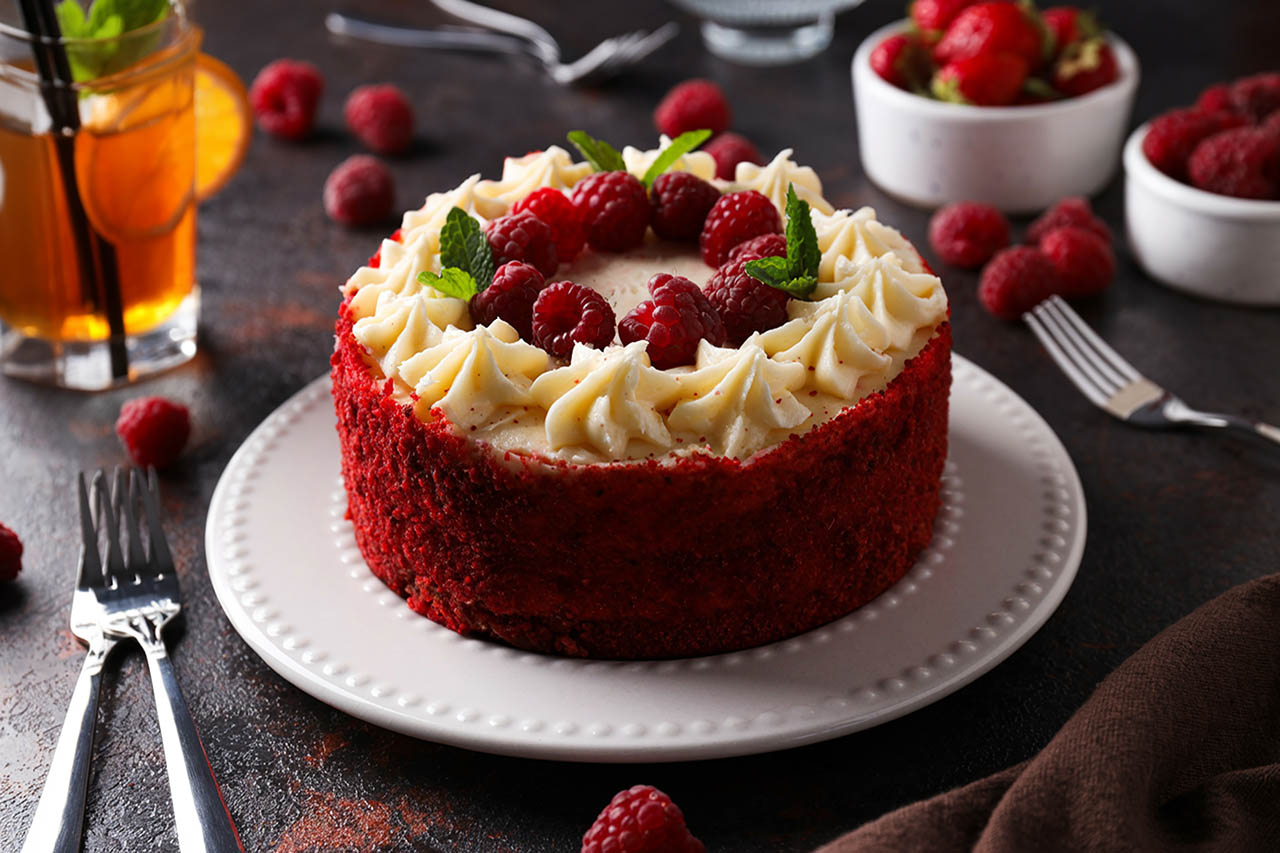Red Velvet Cake
Naturally-Dyed Red Velvet Cake with Beets and Cream Cheese Frosting
Yossy Arefi, celebrated author of Sweeter Off the Vine (Ten Speed Press), masterfully reminds us that beauty—and flavor—can come from the most natural of places. Her naturally dyed red velvet cake reimagines the classic with the rich, earthy magic of beets instead of red dye.
 Like all great recipes, it’s been made even more legendary by Sharon Davidson, whose many renditions have become something of a rite of passage in kitchens that believe in “not from the box” baking. Sharon says, “It takes a bit of time (and practice), but baking this recipe is a triumph of boldness.” Dare to bake it, and you just might channel your inner Dame.
Like all great recipes, it’s been made even more legendary by Sharon Davidson, whose many renditions have become something of a rite of passage in kitchens that believe in “not from the box” baking. Sharon says, “It takes a bit of time (and practice), but baking this recipe is a triumph of boldness.” Dare to bake it, and you just might channel your inner Dame.
“A party without cake is just a meeting.”
Prep Time
1 hour 20 minutes
Cook Time
20 minutes (longer based on altitude)
Total Time
1 hour 40 minutes
Serving
Makes an 8-inch cake with two layers
Ingredients
FOR THE CAKE
- 1 cup beet purée, from fresh red beets (not cooked)
- 3/4 cup buttermilk
- 1 tablespoon white wine vinegar
- 2 tablespoons lemon juice
- 1 tablespoon vanilla extract
- 2-1/2 cups cake flour
- 3 tablespoons cocoa powder, not Dutch-process
- 2 teaspoons baking powder
- 1 teaspoon cream of tartar
- 1 teaspoon salt
- 1/2 cup neutral-flavored oil
- 1/2 cup unsalted butter, softened
- 2 cups granulated sugar
- 3 large eggs
FOR THE CREAM CHEESE FROSTING
- 8 ounces cream cheese, at room temperature
- 8 ounces unsalted butter
- 2 tablespoons crème fraîche
- 1 pound confectioners’ sugar
- 1/2 teaspoon lemon zest
- 1 teaspoon vanilla extract
- 1 pinch salt
Key Considerations
KEY CONSIDERATIONS FOR USING BEET PUREE:
- Acidity Balance: Maintaining an acidic batter is essential to preserve the red color. Ingredients like vinegar, lemon juice, and buttermilk help achieve this balance.
- Beet Preparation: Cooking and pureeing fresh beets is the most common method. Some recipes use beetroot powder, but fresh puree tends to provide a more vibrant color.
- Flavor Profile: When prepared correctly, the beet flavor is subtle and complements the cocoa, resulting in a classic red velvet taste without earthy overtones.
Creating a naturally colored Red Velvet Cake using beet puree is a wonderful idea, especially considering recent FDA regulations regarding red dye. Beets not only impart a beautiful red hue but also add moisture and subtle earthy sweetness to the cake.
Preparation
FOR THE CAKE:
- Preheat oven to 350° F (175° C) and position a rack in the center of the oven. Butter two 8-inch cake pans and line them with parchment paper. Butter the paper too, then dust the pans with flour.
- Add the beet purée, buttermilk, vinegar, lemon juice, and vanilla extract to a food processor fitted with the steel blade and process until very smooth.
- Sift the cake flour, cocoa powder, baking powder, cream of tartar, and salt together in a bowl.
- In a large bowl, beat the sugar, oil, and butter together until creamy. Add the eggs one at a time, mixing for 30 seconds after each addition.
- Alternating, add the flour mixture and beet mixture, beginning and ending with the flour mixture. Divide between the prepared pans and bake until your cake tester inserted into the center of the cake comes out clean, 20 to 30 minutes. Note that some people feel it needs a bit longer than this.
- Cool the cakes on a rack for 20 minutes, then invert onto the rack to cool completely.
FOR THE CAKE:
- Preheat oven to 350° F (175° C) and position a rack in the center of the oven. Butter two 8-inch cake pans and line them with parchment paper. Butter the paper too, then dust the pans with flour.
- Add the beet purée, buttermilk, vinegar, lemon juice, and vanilla extract to a food processor fitted with the steel blade and process until very smooth.
- Sift the cake flour, cocoa powder, baking powder, cream of tartar, and salt together in a bowl.
- In a large bowl, beat the sugar, oil, and butter together until creamy. Add the eggs one at a time, mixing for 30 seconds after each addition.
- Alternating, add the flour mixture and beet mixture, beginning and ending with the flour mixture. Divide between the prepared pans and bake until your cake tester inserted into the center of the cake comes out clean, 20 to 30 minutes. Note that some people feel it needs a bit longer than this.
- Cool the cakes on a rack for 20 minutes, then invert onto the rack to cool completely.
FOR THE CREAM FROSTING:
- To make the frosting: Beat the butter and cream cheese together on high speed until fluffy and smooth add the crème fraîche. Turn the mixer to low and gradually add the confectioners’ sugar until just combined, then turn the mixer up to medium-high and beat until fluffy and smooth, making sure to stop the mixer and scrape down to the bottom of the bowl so everything is evenly mixed. Add the lemon zest, vanilla extract, and salt.
- To assemble the cake: Trim the tops of the cake layers so they are flat, if necessary. Place one layer on a serving plate or pedestal and spread about 1 cup of frosting on top. Top with the second cake layer, then smooth a thin coat of frosting on the outside of the cake. Chill for at least 30 minutes, then cover the cake with a second, heavier coat of frosting to finish.
This show-stopping red velvet cake doesn’t whisper elegance—it declares it. Made with real beet purée and crowned with cream cheese frosting, it’s a celebration of natural beauty, fearless baking, and unapologetic flair. Bake it when you’re channeling your inner Dame—or when you just need something glorious and red on a Tuesday.
FOR THE CREAM FROSTING:
- To make the frosting: Beat the butter and cream cheese together on high speed until fluffy and smooth add the crème fraîche. Turn the mixer to low and gradually add the confectioners’ sugar until just combined, then turn the mixer up to medium-high and beat until fluffy and smooth, making sure to stop the mixer and scrape down to the bottom of the bowl so everything is evenly mixed. Add the lemon zest, vanilla extract, and salt.
- To assemble the cake: Trim the tops of the cake layers so they are flat, if necessary. Place one layer on a serving plate or pedestal and spread about 1 cup of frosting on top. Top with the second cake layer, then smooth a thin coat of frosting on the outside of the cake. Chill for at least 30 minutes, then cover the cake with a second, heavier coat of frosting to finish.
This show-stopping red velvet cake doesn’t whisper elegance—it declares it. Made with real beet purée and crowned with cream cheese frosting, it’s a celebration of natural beauty, fearless baking, and unapologetic flair. Garnish with fresh red raspberries and mint leaves for a final flourish that’s as radiant as it is refreshing. Bake it when you’re channeling your inner Dame—or when you just need something glorious and red on a Tuesday.
Pair with Tea & Trivia
A Slice of History: Iced Tea
ICED TEA is a refreshing beverage with an interesting history. It first gained popularity during the 19th century. While people in other parts of the world enjoyed hot tea, Americans began experimenting with serving tea cold to combat the summer heat.
The first known iced tea recipe appeared in an 1876 cookbook called Housekeeping in Old Virginia, written by Marion Cabell Tyree. However, it wasn’t until the 1904 World’s Fair in St. Louis that iced tea became a nationwide sensation. Richard Blechynden, a tea vendor, decided to serve his tea over ice to attract more customers in the sweltering summer heat.
The cool, refreshing drink was an instant hit, and iced tea’s popularity has continued to grow ever since.
Today, iced tea comes in many varieties, including sweetened, unsweetened, flavored, and even layered with fruit or herbal infusions.
TRIVIA SIP: Did you know? Iced tea made such a splash at the 1904 World’s Fair that vendors ran out of ice by midday. Turns out, a simple cube or two was all it took to change how America sipped its tea—forever cooler, one glass at a time.

ICED VANILLA ROOIBOS TEA
Naturally caffeine-free and gently sweet, rooibos won’t clash with the richness of the cake. Served iced, it adds a light, refreshing contrast to the cake’s decadence—perfect for warmer days or elegant gatherings.
You can even garnish it with a slice of orange or a sprig of mint for that extra Dame detail.

